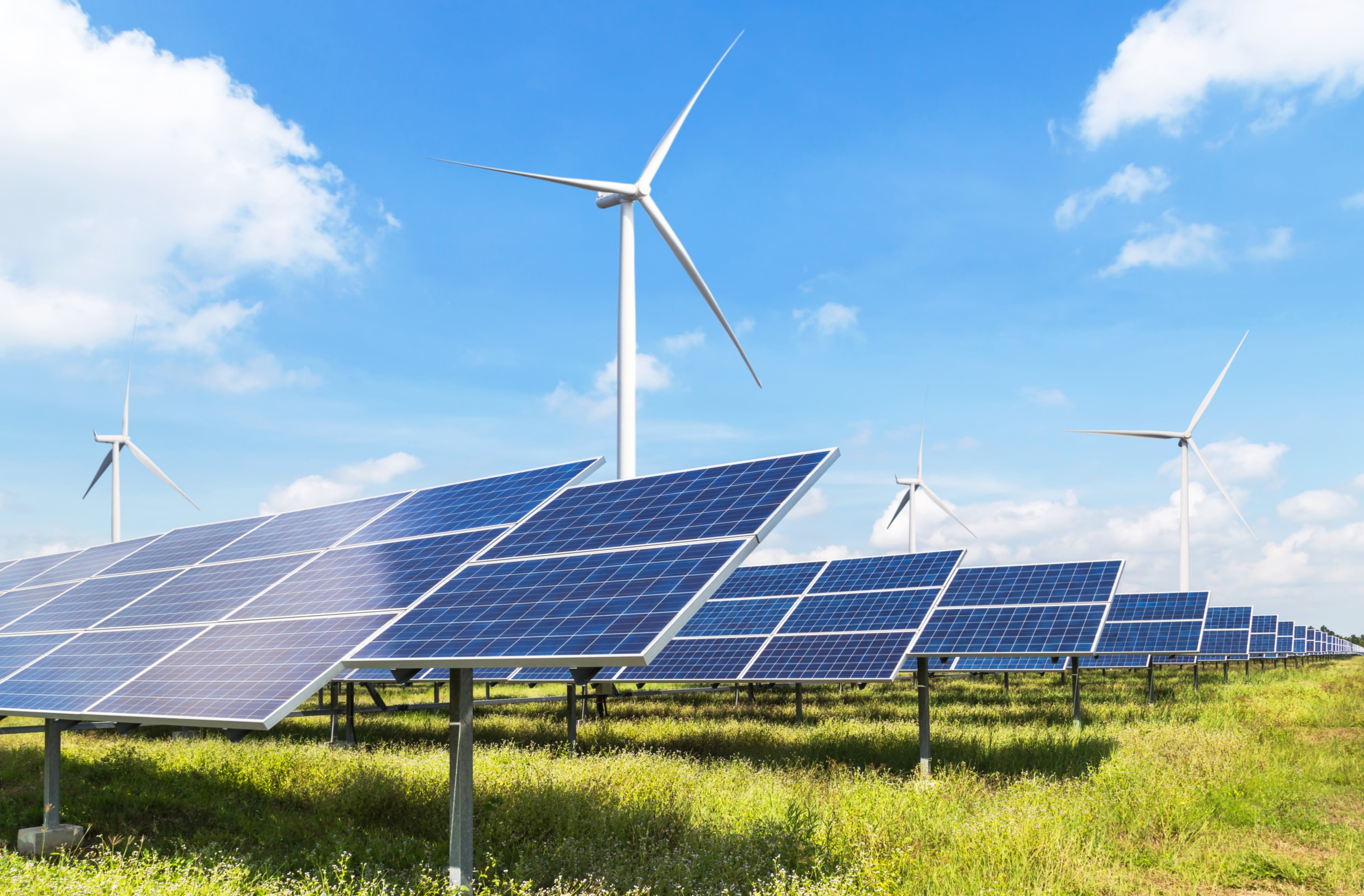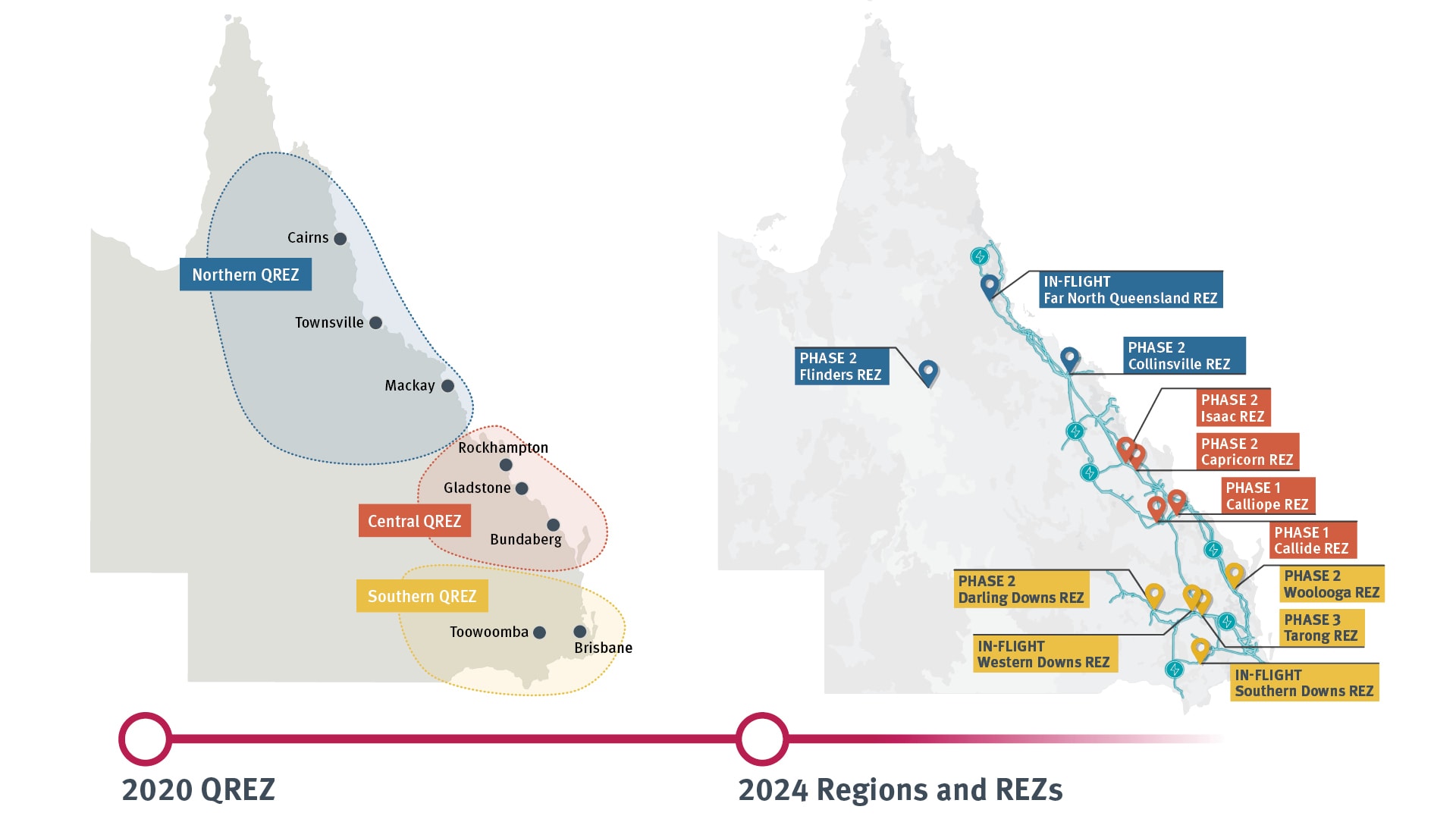What are Queensland Renewable Energy Zones?
What are Queensland Renewable Energy Zones?

As Queensland continues to decarbonise its energy supply and move towards renewable resources, the state government has identified 12 renewable energy zones that are expected to be crucial to the transformation.
The Queensland Energy and Jobs Plan sets an ambitious target for 80 per cent of the state’s power to come from renewable sources by 2035. (At the time the Plan was released, only 21.4 per cent of the electricity used in Queensland came from renewables.)
To reach this target without compromising the grid’s ability to deliver affordable, reliable and secure energy, the government is working to establish a $62 billion ‘super grid’ by 2035, connecting renewable energy projects across the state with storage and transmission infrastructure.
The development of Queensland Renewable Energy Zone (QREZ) regions is key to this plan.
What is a renewable energy zone?
A renewable energy zone (REZ) is an area that’s strategically planned to connect multiple renewable energy generators and storage technologies in the same location, and pair them with high-voltage poles and wires. This way, renewable energy can reliably and efficiently reach homes and businesses with minimal transmission loss.
REZs should be located in areas with high quality renewable resources (i.e. plenty of wind and sun), and consider factors such as existing grid infrastructure, and the environmental, community and economic implications of development in the area. This includes comprehensive planning for associated ports, roads, bridges, waste management, water, workforce and housing requirements.
REZs allow for coordinated energy infrastructure development that takes advantage of economies of scale. This supports the delivery of cost-effective, grid-connected renewable energy that puts downward pressure on electricity prices.
Where will Queensland’s Renewable Energy Zones be located?
In March 2024, after consulting with stakeholders and communities from across the state, the Queensland Government released the Queensland Renewable Energy Zone Roadmap.
The Roadmap identifies 12 potential renewable energy zones across Queensland, which fall into three distinct regions – Southern Queensland (five zones), Central Queensland (four zones), and North and Far North Queensland (three zones).

Development of these zones is split into the following phases – In-Flight (already underway, with key foundation projects in development); Phase 1 (to be developed in the early-to-mid 2020s); Phase 2 (mid-late 2020s) and Phase 3 (early 2032s).
These locations were identified in consultation with Powerlink, Queensland’s publicly owned transmission company, based on their network capacity, project pipeline and land use analysis.
In total, the Roadmap outlines the pathway for about 22 gigawatts (GW) of new solar and wind generation to be connected within the zones, which will be needed to reach Queensland’s renewable energy targets.
The Queensland Government expects that efficiency savings through coordinated REZ development could lower Queenslanders’ household electricity bills. The government also anticipates that REZs will deliver a pipeline of approximately 4,000 direct renewable energy construction jobs.
North and Far North Queensland
The North and Far North Queensland region spans from Cairns in the north to Mackay in the south.
It also extends out west to Hughenden, which is expected to be opened up for new renewable energy development by the CopperString 2032 transmission project, a 1,100 km high-voltage transmission line from Townsville to Mount Isa that will connect the North West Minerals Province (NWMP) to the national electricity grid.
Three potential REZs have been identified for this region, to be connected incrementally – the Far North Queensland REZ, which is already underway; Flinders REZ, which is earmarked for Phase 2, and Collinsville REZ, which is proposed for Phase 3.
Up to 5,100 megawatts (MW) of new renewable generation is projected to be installed between these three REZs.
Central Queensland
The Central Queensland region spans from Moranbah in the north to Bundaberg in the south, and west past Emerald.
The four proposed REZs in the region are Calliope and Callide (earmarked for Phase 1), and Isaac and Capricorn (Phase 2), with up to 8,200 MW of new renewable generation projected to be installed between them.
Considered the energy powerhouse of Queensland, the Central Queensland region is already home to some of the state’s most significant traditional generation assets, as well as some of Queensland’s largest energy consumers and most energy-intensive industries, including agriculture, construction, minerals processing and manufacturing.
The government-owned Stanwell Power Station, which is expected to transition into a clean energy hub by 2035 as Queensland’s reliance on coal-fired energy lessens, is located within this region.
The Central Queensland region is also home to the Clarke Creek Wind Farm, an 800 MW wind project located approximately 150 kilometres north-west of Rockhampton, which will become one of the largest wind farms in the southern hemisphere upon completion.
Renewable hydrogen also presents an exciting opportunity for the region. Stanwell’s CQ-H2 project includes the development of a large-scale renewable hydrogen production facility at Aldoga, as well as a hydrogen transport facility (pipeline), and a liquefaction and shipping facility at the Port of Gladstone. The project will also supply renewable hydrogen to an ammonia production facility.
Over its 30-year life, the project is expected to deliver $17.2 billion in hydrogen exports and add $12.4 billion to Queensland’s Gross State Product. At its peak, the CQ-H2 Project could support more than 8,900 new jobs.
A feasibility study for the project was successfully completed in 2022, with a Front End Engineering Design (FEED) study now underway.
Southern Queensland
The Southern Queensland region, spanning from Maryborough in the north to Stanthorpe in the south, and west to Chinchilla, is known for its agricultural production and strong primary industries, including food and fibre production, and has seen an increase in large-scale wind and solar farms in recent years.
The Southern Queensland region is home to five potential QREZs. Two of these – the Western Downs and Southern Downs – are already underway, with another two (Woolooga and Darling Downs) earmarked for Phase 2 and a fifth (Tarong) proposed for Phase 3.
Up to 12,200 MW of new renewable generation is projected to be installed between the five REZs, which are already home to a strong pipeline of projects.
The government-owned Tarong Power Station is expected to become the clean energy hub of the Tarong REZ. The proposed Tarong West Wind Farm will also be located within this REZ, while the 252 MW Wambo Wind Farm, which is expected to commence commercial operations from 2025, will be located within the Western Downs REZ.
What’s next?
The Queensland Government expects the Energy (Renewable Transformation and Jobs) Bill to be debated and passed in 2024, locking in energy targets and establishing governance and infrastructure frameworks to support the development of QREZs.
As new opportunities and future industries emerge over time, the government has also left the door open for additional REZs to be identified. The Roadmap will be updated every two years, along with the Queensland SuperGrid Infrastructure Blueprint.
While there’s still much to be determined and developed, it’s clear that QREZs will play an important role in securing a reliable and stable energy network for Queensland – now and into the future.
Subscribe to our newsletter
STANWELL SPARK
Stay up to date with quarterly news from Stanwell, delivered straight to your inbox. Learn more about our projects, partnerships and how we're delivering affordable, reliable and secure electricity for Queensland.